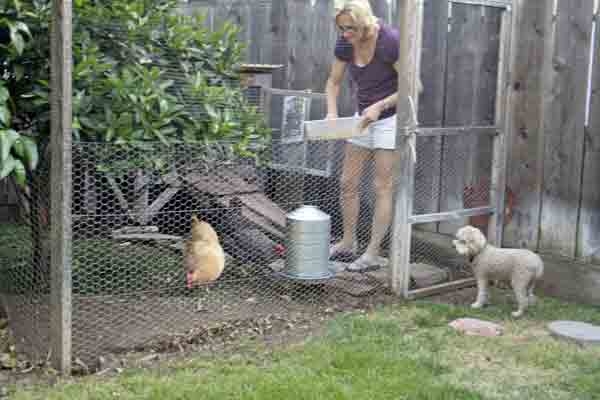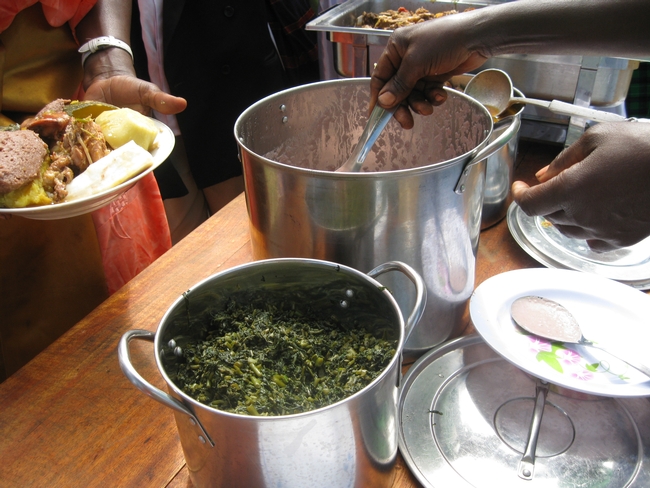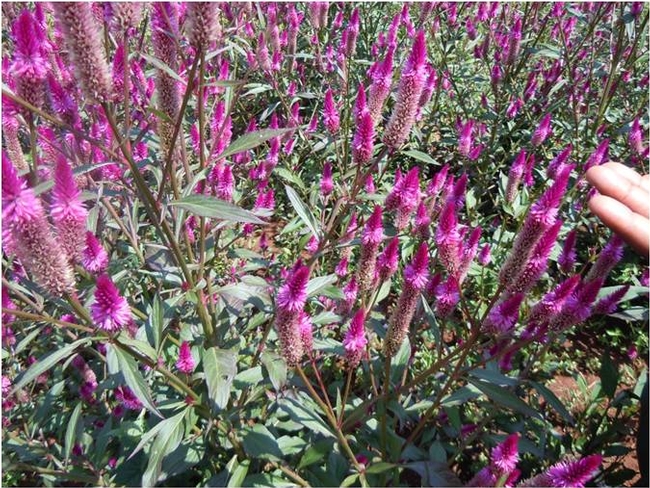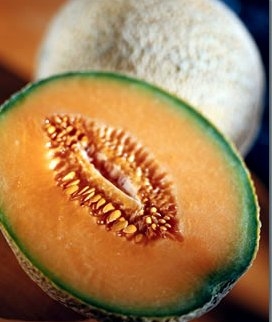UC Food Blog
More African vegetables on more plates
What will be the new food frontier? An article in the Wall Street Journal with the headline “Next Stop for Food Fanatics: Africa” predicts adventurous American palates may soon be craving sub-Saharan cuisines.
Have you heard of these?
- Nakati (Solanum macrocarpon, S. aethiopicum) Also called African eggplant, some types of nakati are eaten for their leafy greens, while others are eaten for their fruit (which can look like a tomato or eggplant).
- Cowpea leaves (Vigna unguiculata) This plant produces black-eyed peas, but the greens of the plant can also be eaten as a vegetable.
- Bbuga (Amaranthus Gracecizans) You might know this plant by its common American name: pigweed.
- Doodo (Amaranthus Dubius) Like bbuga, this type of amaranth is eaten for its leaves in many parts of Africa. In North and South America, varieties of amaranth are usually used as a grain.
- Jjobyo (Gynandropsis Gynandra, Cleome gynandra) Also called spider plant.
Many of these indigenous vegetables are rich in micronutrients such as iron, vitamin A and vitamin B. When it comes to alleviating malnutrition in developing countries of eastern Africa, indigenous vegetables offer workable solutions because they are not only nutritious, but also familiar to the region’s eaters and farmers.
But research into these vegetables has often not been a priority, even among international development professionals. Markets for these vegetables are also largely undeveloped because they are widely considered subsistence crops, often grown in small garden plots by women for their own families. But growing these crops commercially can mean increased income for smallholder farmers and improved nutrition for consumers who crave traditional foods.
Recently U.S. researchers have been working with indigenous crops like these in east African countries — with funding and support from the Horticulture Collaborative Research Support Program (Horticulture CRSP), led by Beth Mitcham at UC Davis with funding from USAID. In Kenya, Tanzania and Zambia, Stephen Weller of Purdue University is leading a Horticulture CRSP research project on production practices, seed resources, postharvest handling, marketing and nutrition of varieties of amaranth, spider plant and African nightshade.
In Uganda, Kate Scow of UC Davis is partnering with local groups to try out a new model of extension while increasing production of indigenous greens, such as nakati, bbuga and jjobyo.
Take a look at this short video for a little more background:
Just as bok choy, an Asian vegetable, has become familiar to many American households, perhaps one day you’ll find nakati or another African leafy vegetable on your plate.
In the meantime, researchers with Horticulture CRSP are working to get more African leafy vegetables into the research agendas, fields, markets and plates of our counterparts in eastern Africa.
Read more abut Horticulture CRSP and its projects around the world at http://hortcrsp.ucdavis.edu.
UC aims to improve economic viability of California blueberry farms
California consumers have grown accustomed to enjoying locally grown blueberries in the last decade. Much of the credit goes to UC Cooperative Extension advisor Manuel Jimenez of Tulare County, who has been studying blueberry production and varieties at the UC Kearney Agricultural Research and Extension Center since 1998.
California’s abundant sunshine enables growers to produce high-quality, very sweet Southern Highbush variety blueberries. But, blueberry plants are difficult and expensive to establish and maintain, in part because of California's soil chemistry.
“Blueberries are adapted to grow in forests, in acidic soils,” Jimenez said. “We’re growing them in a desert in alkaline soil. That requires that we acidify the soil when we establish the crop and continuously acidify the irrigation water – which is very costly.”
For example, a 2009 Blueberry Cost Study produced by UC Davis calculated that equipment needs for acidification - including a storage tank, pump and monitoring kit - amounts to $5,500. In addition, the growers must purchase large quantities of sulfuric acid to add to the soil and irrigation water.
Reducing acidification cost is the goal of a new blueberry trial at Kearney, in which Jimenez has grafted the most common commercial blueberry varieties on the roots of farkleberry plants (Vaccinium arboreum). Farkelberry is a small, stiff-branched evergreen bush that is more tolerant of alkaline soils than blueberries.
So far, the two-month-old plants seem to be growing well in their naturally alkaline soil. The coming years will reveal whether using this technique will improve the economic viability of California blueberry farms and provide California consumers with local, healthful and delicious blueberries at a reasonable cost.
The project is being conducted in collaboration with Oregon State University and Florida State University.
Learn more about the blueberry trial by viewing the video below:
Grafting 640 x 360
Raising chickens at home is rewarding
Backyard chickens are pets with perks. Laying hens provide a steady supply of fresh, organic eggs; unusual breeds can satisfy birdwatchers' desire to observe an animal exploring its surroundings; and poultry manure is an excellent soil amendment.
Surprisingly, chickens are pretty good companion animals as well. My family keeps two chickens in a 10-foot-square pen in the side yard of our tract home. The birds are as thrilled to see us at the end of the day as our dog and cats. They provide enough eggs for us to share with neighbors and, as one might expect, their food expenses amount to chicken feed.
Chicken rearing in urban areas seems to be keeping pace with growing interest in gardening. Among the California cities that permit backyard chickens are San Francisco, Anaheim, Long Beach, Oakland, Bakersfield and San Diego. Last summer, the Sacramento City Council passed an ordinance that allows citizens to raise up to three chickens in their backyards. Before bringing home chickens, check to see whether they are permitted under local ordinances where you live.
UC Cooperative Extension offers resources on selecting and caring for chickens. A free pamphlet, Selecting Chickens for Home Use, has guidelines for people who want chickens for eggs, meat or exhibition stock.
The best egg-laying breeds, the authors say, are Rhode Island Red, New Hampshire Red and Single-Comp White Leghorn. Characteristics sought for meat producers include fast growth and efficient feed utilization. The most common meat chicken is a cross between White Plymouth Rock hens and White Cornish cocks.
Chicken rearing is a popular 4-H project that goes back to the inception of the program in California nearly 100 years ago. At the outset, UC Cooperative Extension 4-H placed a heavy emphasis on farm production and farm family activities. As the state became increasingly urban and suburban, the scope of 4-H expanded into such projects as recycling, robotics, foods and nutrition and leadership. Now that popular culture is turning Californians back to rural roots - raising chickens and tending vegetable gardens - 4-H is uniquely poised to show them how.
The California 4-H Poultry Project Sheet can be used to engage children in raising backyard chickens, whether they are enrolled in 4-H or not. The National 4-H poultry curriculum details the responsible and humane care and raising of chickens. It outlines the the best management practices used on farms and in industry and the value of poultry meat and eggs in human nutrition.
The 4-H poultry curriculum is available for a nominal cost in the 4-H online store.
Get more information about enrolling in 4-H on the UC 4-H Youth Development Program website.

Chickens make great pets.
Unripe cantaloupe? Could be, the electronic nose knows
You know how it works: You stand in the grocery aisle, surreptitiously sniffing the cantaloupes, hoping your nose will lead you to a nice, ripe selection. But when you slice it open in your kitchen, it’s just not as ripe as you had hoped. Lucky for you (and me), UC Davis Department of Plant Sciences Assistant Professor Florence Negre-Zakharov and her team may have found a way to make imperfectly ripe fruit a thing of the past.
"We are involved in a project geared towards developing rapid methods to evaluate ripeness and flavor of fruits," explained Negre-Zakharov, who authored a paper on the method published in the March 30 edition of the Journal of Visualized Experiments (JoVE). "We evaluated an electronic nose to see if it can differentiate maturity of fruit, specifically melons. The goal is to develop a tool that can be used post-harvest to better evaluate produce, and develop better breeds."
When fruit ripens, it develops a characteristic volatile blend, indicating its maturity. Traditionally, the gold-standard of evaluating these volatiles has been gas chromatography, but it takes up to an hour to analyze a single sample, which makes it impractical to use outside the lab. Negre-Zakharov’s team wanted to determine if the much cruder — but much faster — electronic nose was able to determine if the melon they used in the experiment were ripe. It was.
"It’s quite encouraging technology for the purposes of determining maturity," she said.
"It's very impressive that the electronic nose system can do a type of gas chromatography in about a minute,” said JoVE science editor Zhao Chen. “Ultra-fast, indeed. Also, the sample preparation is as easy as making a smoothie at home. Such a user-friendly system could greatly help analysis efficiency in this field. Given the popularity of JoVE video-articles, I expect many researchers will know and adopt this method in their own research."
As a next step, the team is testing the electronic nose out in the field to see if it can still determine fruit maturity despite interference from all the background smells like soil and farm air. They hope to have results from those tests soon.
You can access a video of the study here.
Healthalicous cooking
Our youth deserve a future filled with promise and possibilities. A strong body and good health is the foundation on which a successful future can be built.
UC ANR’s new after-school curriculum is designed to help 9- to 12-year-olds develop good health skills that will last a lifetime. The six-week hands-on program promotes preparing and eating healthy meals as well as encouraging plenty of physical activity. Healthy eating and physical activity work together to help reduce obesity levels.
These free, downloadable lessons include:
- Let’s Make It Clean: Wash Up!
- Make It Healthy: Eat Balanced Meals
- Make It Crunchy: Go for Whole Grains!
- Make It Colorful: Choose Fruits and Veggies by Color
- Make it Delicious: Plan and Balance
- Make It Fun: Eat and Share







